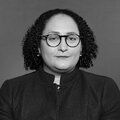Arguing for judges with exposure to America’s diverse mores, NAACP LDF’s John Payton reminded an audience of lawyers, professors and students at NYU School of Law of the historical and racial context of the current Supreme Court pick.
John Payton, President and Director-Counsel of the NAACP Legal Defense Fund appeared at a panel discussion hosted by the Brennan Center entitled, "Umpire? Empathy? What Do We Want in a Supreme Court Justice?” on Monday, June 15, 2009 along with Burt Neuborne, Stanley Fish, and Dahlia Lithwick.
Eschewing an endorsement of “empathy” per se as criteria for good judging, Payton urged that what a good judge does is try to imagine what it would be like to be in someone else’s shoes in order to come to a just decision. As an example of the dangers of thinking of the law as neutral, Payton quoted from Professor Herbert Wechsler’s famous Holmes Lecture at Harvard Law School. Toward Neutral Principles of Constitutional Law, 73 Harv. L. Rev. 1 (1959):
In the days when I was joined with [African American Attorney] Charles H. Houston in a litigation in the Supreme Court, before the present building was constructed [in 1935], he did not suffer more than I in knowing that we had to go to Union Station to lunch together during the recess [since blacks were not allowed in the Capitol dining room].
Wechsler likely thought he was being neutral when he asserted that being excluded from a dining room because he was a white man who wanted to dine with Houston, a founder of LDF, was the same as Houston being excluded for being black. Payton was incredulous that Wechsler, was proud of his insularity from the experiences of others unlike himself and so misread the demoralizing indignity experienced by black men like Charles H. Houston upon being excluded from restaurant because of their race.
Payton argued by analogy quoting Justice O’Connor in Grutter, the Michigan Law School Affirmative Action case, that “nothing less than the nation’s future depends upon leaders trained through wide exposure to the ideas and mores of students as diverse as this Nation of many peoples.” Payton, who was a lawyer in the Grutter case, explained the positive effects of educational diversity related to him by the Michigan Law School faculty. A Michigan property law professor noted that when women entered the classroom, they brought up different topics than when the classroom was all male. These new topics were an enriching addition to the class that improved the learning environment for all students. Payton urged that likewise what we need in any future Supreme Court Justice to have broad exposure to America’s diverse ideas and mores.
Noting that when the NAACP Legal Defense Fund was founded in 1940, it faced a host of laws that required discrimination against black people, Mr. Payton reminded the audience that there was a long American jurisprudence based on white supremacy which has been quietly dropped from the case books taught in law schools.
Payton argued that the ideas that law is neutral and that judges are mere umpires were used to justify racially discriminatory legal decisions that are embarrassing to read today. To Payton, by contrast, the seminal desegregation case Brown v. Board of Education was animated by a conception of the Constitution which conformed to the needs of democracy. He worried that the trope of judges as umpires constructs judges as strangers to democracy.
For many decades LDF brought its path-breaking desegregation and anti-discrimination cases in front of white male Justices who were isolated from the fullness of American life: these Justices had no Black peers, no Hispanic peers, no Asian peers and until Justice O’Connor’s appointment in 1981, no female peers. Indeed they argued in front of the likes of Justice James McReynolds who would literally turn his chair backward so that he would not look at black lawyers during oral argument.
Echoing themes that are outlined in the Brennan Center’s recent publication, Improving Judicial Diversity, Payton argued that such homogeneity of experience limited the Justices’ imagination of what a democracy could be. As an example of a failure of imagination, Payton noted Justice Oliver Wendell Holmes’ holding in Giles v. Harris that the claim that all blacks were denied the right to vote in Alabama was nonjusticiable. Holmes wrote in 1903:
The bill imports that the great mass of the white population intends to keep the blacks from voting. To meet such an intent, something more than ordering plaintiff’s name to be inscribed upon [the voting rolls] will be needed. If the conspiracy and the intent exist, a name on a piece of paper will not defeat them.
Holmes, and the Court he sat on, consequently left the vote-less black Alabamans to the mercy of the hostile white majority and gave them no judicial relief.
In closing, Payton noted that if we had a hypothetical nominee who was a brilliant jurist but whose only experience was practicing law in Bulgaria, that such a judge would not be an appropriate Justice for the US Supreme Court because she would be missing a sense of who we are as Americans, and how we got here as a people. Without this exposure to the diversity of the American context, such a judge might not fully appreciate the disputes before her.
